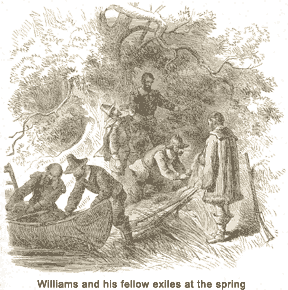Claims of early European contact with Rhode Island are similar to those of other areas in New England. Norsemen, Irish, Portuguese and others have advocates claiming visits to the region, but lack widely accepted evidence.
In 1524, Giovanni da Verrazzano, searching for an all-water route to the East, explored Rhode Island waters and recorded details about the Native Americans he encountered in Narragansett Bay. In his writings, Verrazzano took note of an island (probably Block Island) that he figured was about the same size as the "Island of Rhodes" in the Mediterranean.
For many years following Verrazzano's voyage, most European exploration extended to the north as the seafarers sought a Northwest Passage. Activity toward the south did not resume until 1614, when John Smith and Adriaen Block sailed along the coastline (the latter naming Block Island after himself). Block wrote of an island in Narragansett Bay as roodt eylandt, noting the color of its red clay.
Rhode Islanders still debate whether Verrazzano or Block was responsible for their state's name.
In 1636, Roger Williams and his followers, reacting to religious repression encountered in Massachusetts and attempting to avoid being sent back to England, sought protection among the Wampanoag in Rhode Island. Lands purchased from the Narragansett provided the location for their first permanent settlement, Providence or Providence Plantations. Other settlements developed around Narragansett Bay in the next few years.
 Portsmouth, originally called Pocasset, was established in 1638 by Anne Hutchinson, William Coddington and their followers. The following year, some members of the group followed Coddington to found Newport in the south.
Warwick was established in 1642 and endured a troubled early history under Samuel Gorton.
Given that the legitimacy of the Rhode Island settlements rested on Native American deeds, other colonies chose to dispute ownerships. To defeat these rival claims, Roger Williams journeyed to England in 1643-44 to secure a Parliamentary patent that would unite the settlements into a single entity, Rhode Island. In 1663, Rhode Island received the most liberal royal charter ever granted. It recognized the colony's self-government status, sanctioned religious liberty and sided with the colony on disputed land issues. This charter remained the basis of Rhode Island's law until 1843.
Religious toleration continued to be the hallmark of Rhode Island, as evidenced by the
Portsmouth, originally called Pocasset, was established in 1638 by Anne Hutchinson, William Coddington and their followers. The following year, some members of the group followed Coddington to found Newport in the south.
Warwick was established in 1642 and endured a troubled early history under Samuel Gorton.
Given that the legitimacy of the Rhode Island settlements rested on Native American deeds, other colonies chose to dispute ownerships. To defeat these rival claims, Roger Williams journeyed to England in 1643-44 to secure a Parliamentary patent that would unite the settlements into a single entity, Rhode Island. In 1663, Rhode Island received the most liberal royal charter ever granted. It recognized the colony's self-government status, sanctioned religious liberty and sided with the colony on disputed land issues. This charter remained the basis of Rhode Island's law until 1843.
Religious toleration continued to be the hallmark of Rhode Island, as evidenced by the